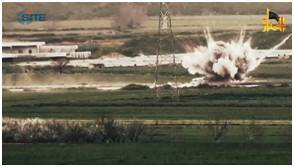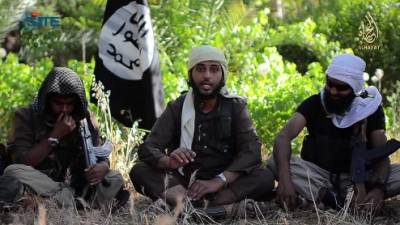Perfect Storm: The Arab Spring and the Syrian Civil War

Beyond any doubt, the Syrian civil war has reversed Core al-Qaeda’s waning fortunes and re-energized its one-time Iraqi spear-carrier, the Islamic State—formerly the Islamic State of Iraq al-Sham (ISIS), Islamic State of Iraq (ISI), and before that, al-Qaeda in Iraq (aQI).
Just two or three years ago, the movement, including ISI and aQI, appeared to be in terminal decline. Bin Laden, Abu Musab al-Zarqawi, aQI’s founder, and his two successors were dead. The movement’s chief Western radicalizer and recruiter, Anwar al-Awlaqi, had been killed. A four-fold increase in U.S. drone attacks between 2009 and 2012 had claimed the lives of more than other three dozen senior al-Qaeda commanders and over two hundred foot soldiers.
Al-Qaeda, moreover, had played no part in the transformative social, political, and economic developments of the Arab Spring—seemingly rendering the movement an irrelevant anachronism. Social media and civil protest, observers fawned, had achieved what terrorism had manifestly failed to deliver, thus marginalizing the terrorists forever. Al-Qaeda, as even bin Laden recognized, was losing the war of ideas and the struggle for Muslim hearts and minds. And, the longing for democracy and economic reform across North Africa and the Middle East that the same optimists enthused had decisively trumped repression and violence.
Today, however, both Core al-Qaeda and the Islamic State have not only revived themselves, but have actually grown and expanded in fighters, controlled territory, and stature. Despite having suffered the greatest onslaught directed against a terrorist organization in history, al-Qaeda’s ideology and brand has nonetheless prospered. Taking advantage of the vacuum of authority created by the upheaval that followed the Arab Spring, and exploiting the proliferation of poorly governed places or patently ungoverned territory—particularly along porous national borders—Core al-Qaeda affiliates and associated groups, along with aQI, moved swiftly to establish new sanctuaries and safe havens in North and West Africa, the Sinai, and the Levant.
More, it is important to note that the successes of al-Qaeda and the Islamic State are not mutually exclusive; to view the Islamic State as anything other than its claims to be the genuine al-Qaeda—resolutely committed to the ideals espoused by its founder and emir, Usama bin Laden—is incorrect. We are not confronted by two distinct entities here, but rather by two sections of the same movement: one upstart claiming the mantle of truth and fidelity, and another striving to remain relevant in a region that has undergone vast change and upheaval.
AQI’s unimpeded success in Syria is a particularly alarming case in point. That organization provided the broader movement precisely the relevance it had been lacking and enabled the movement, again, to become a player and force in Middle Eastern politics. The group’s re-branding as ISIS and attempts to absorb Jabhat al-Nusra, the Syrian-based clone that the ISIS had created, evidenced its newly acquired strength and confidence. Significantly, too, the military coup that toppled the regime of Mohammad Morsi in Egypt further contributed to the movement’s credibility and appeal—seeming to validate Ayman al-Zawahiri’s admonitions about having any faith in the West and the sanctity of democratic processes.
Geographic and Technological Sanctuaries
Thirty years ago, British Prime Minister Margaret Thatcher said that publicity provides the oxygen that terrorists breathe. In al-Qaeda’s and the Islamic State’s cases, continued access to sanctuary and safe haven is the oxygen that sustains both and has enabled the movement to expand both geographically and numerically in terms of fighters over the past few years.
Today, al-Qaeda is present in more places than it was on the eve of the September 11, 2001 attacks. It currently operates in at least sixteen regions or countries—more than double the number of six years ago.* And, despite repeated U.S. government proclamations heralding its impending strategic collapse, Core al-Qaeda has demonstrated a remarkable resiliency.
Syria has played an especially pivotal role in al-Qaeda’s efforts both to re-insert itself back into the region’s politics and to appear relevant. The country is regarded as treasured Muslim territory, referred to by the Koran and the site of historical conflict between Sunni and Shi’a (e.g., the Nusayaris, the ancient name for the Alawites and Shi’a). What is today Syria was formerly a province of the Ottoman Empire that was administered from Damascus and included Islam’s third holiest shrine, Jerusalem’s al Aqsa Mosque and Dome of the Rock. It is also geographically connected to two of the movement’s most hated enemies: the Hashemite Kingdom of Jordan and the Jewish state of Israel, therefore presenting tremendously appealing targets for the struggle’s next phase.

There are also already indications that Syria’s ongoing civil war, coupled with the focus on the use of chemical weapons by both government and opposition forces, have sharpened both groups’ interests and ambitions to obtain nerve agents, poison gas, and other harmful toxins for use as weapons. For example, in May 2013 Turkish authorities reportedly seized two kilos of sarin nerve gas—the same weapon used in the 1995 attack on the Tokyo subway system—and arrested twelve men linked to al-Qaeda’s Syrian affiliate, Jabhat al Nusra. Only days later, another set of sarin-related arrests was made in Iraq of ISIS operatives overseeing the production at two factories of both sarin and mustard blistering agents. And, in November 2013, Israel reported that for the previous three years it has been holding a senior al-Qaeda operative with expertise in biological warfare.
Not surprisingly, both Syria and Iraq are often described as the “perfect jihadi storm,” much like Afghanistan was three decades ago: magnets for foreign fighters with violence theologically justified by fatwas (religious edicts) provided by leading Muslim clerics and where rebels, including core al-Qaeda loyalists like Jabhat al Nusra and renegade groups such as the Islamic State, have benefitted from the largesse of wealthy Arabian Gulf patrons. But a critical distinction between the struggle in Afghanistan during the closing decades of the twentieth-century and Syria and Iraq in the early twenty-first-century is the evolution of information technology and communications that has occurred in recent years.
The growth and communicative power of social networking platforms such as Facebook, YouTube, Twitter, Instagram, Flickr, WhatsApp has transformed terrorism—facilitating both ubiquitous and real-time communication between like-minded radicals with would-be recruits and potential benefactors, thus fueling and sustaining these struggles to a new extent. Hence, it is common nowadays for foreign fighters participating in these conflicts to amass thousands of followers on platforms such as Twitter and Facebook. They communicate with their audiences often on a daily basis—sometimes multiple times each day—providing first-hand, immediate accounts of heroic battles and more mundane daily activities, making jihad accessible and comprehensible on a uniquely intimate and personal basis.

Fighters invite, motivate, animate, and summon their Twitter followers and Facebook friends to come to Syria and Iraq and partake of the holy war against the Assad and Malaki regimes. Blatant sectarian messaging and divinely ordained clarion calls to resist Persian domination and help determine the outcome of the eternal struggle between Sunni and Shi’a—and the latter’s Alawite satraps—provide additional, compelling incentives. A recent ISIS recruitment video posted on the Internet, for example, featured heavily armed militants with distinctive British and Australian accents trumpeting the virtues of jihad and the ineluctable religious imperative of joining the caravan of martyrs.
It is therefore not surprising to find that all of al-Qaeda’s most important affiliates—al Shabaab, Ansar al-Sharia, Boko Haram, the Abdullah Azzam Brigades, al-Qaeda in the Islamic Maghreb, al-Qaeda in the Arabian Peninsula, Jabat al Nusra, and the Afghan Taliban, as well as the outlawed Islamic State—all have Twitter accounts on which they regularly tweet.
The advantages of the new social media to terrorists are manifold. Ease, interactivity and networking, reach, frequency, usability, stability, immediacy, publicity, and permanence are benefits reaped by those terrorist groups exploiting and harnessing these new technologies. A new generation of celebrity fighters is also being created, heralded and extolled in a familiar vernacular to Facebook friends and Twitter followers throughout the world.
*Pre-2008 networks and locations al-Qaeda in the Far East (Indonesia and the Philippines); al-Qaeda in Afghanistan; al-Qaeda in in Pakistan; al-Qaeda in in East Africa (al Shabaab); al-Qaeda in in Iraq; al-Qaeda in the Islamic Maghreb (Algeria) and, al-Qaeda in in Europe. Since 2008, al-Qaeda in has expanded to the Sudan (al-Qaeda in in the Two Niles); Tunisia (Ansar al Sharia); Lebanon; Libya, Mali, Mauritania, Niger, and Nigeria (AQIM); Syria (Jabhat al Nusra and associated groups); and, North America (e.g., the 2009 suicide bomb plot to attack the New York City subway system and the 2013 plot to attack trains in Canada).
